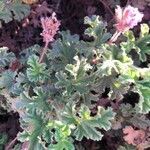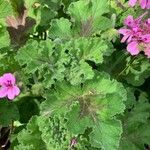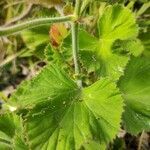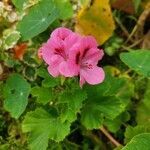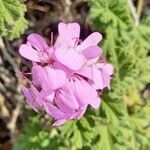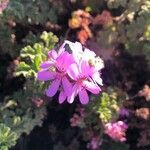Erect, much-branched, strongly rose-scented shrub, 0.6-1.3 m high; stems herbaceous becoming woody; densely villous, densely interspersed with glandular hairs. Leaves simple, lamina cordiform, up to 55 x 100 mm, palmatipartite to pinnatisect, segments at least 3 mm wide, adaxially grooved, apex obtuse or acute, margins irregularly serrate, revolute; adaxially sparsely villous, green, abaxially almost lanate, greyish green; petioles up to 80 mm long. Inflorescences of 3-7-flowered pseudo-umbels; peduncles up to 40 mm long. Petals 5, white to pinkish; posterior 2 spathulate, up to 30 x 8 mm, apex obtuse to emarginate, markings red; anterior 3 spathulate up to 22 x 5 mm. Flowering time Aug.-Jan.
Leaf-lamina 2–7 × 2·5–8 cm. (2·3 × 2·5–4 cm. in E.M.&W. 348), broadly ovate to depressed-ovate, pinnatipartite or sometimes almost palmatipartite, cordate at the base; two basal segments much larger than the rest and often further subdivided with segments often pinnatilobed and irregularly dentate, margin revolute; petiole l·5–4 (8) cm. long (0·2–1·7 cm. in E.M. & W. 348); stipules 4–9 × 3–7 mm., deltate to broadly ovate, acute, often bifid, membranous.
Suffrutex up to 1·3 m. tall, strongly aromatic; internodes 1–8 cm. (or 0·2–1 cm. in E.M.&W. 348) long; vegetative parts, peduncles and pedicels glandular and pubescent, tomentose when young, hairs patent or ± oppressed on the leaves, glands short-stalked to ± sessile.
Inflorescence a pseudumbel of (1) 2–5 (7) flowers; peduncle (0·2) 1–4 cm. long, leaf-opposed or in the axil of the smaller of 2 apparently opposite leaves; bracts 3–8, 5–8 × 2–4 mm., ovate, membranous; free part of pedicel (2) 4–8 (10) mm. long.
Shrub to 1 m. Leaves palmatifid, shortly hairy, strongly rose-scented, ± 4 cm diam. Flowers to 7 on short, axillary peduncles, ± 30 mm diam., white to pinkish purple; hypanthium 4-15 mm long, longer than pedicel.
Petals pink with darker veins; 2 posterior ones (14) 17–20 × 5–5·6 (6) mm., spathulate; 3 anterior ones (11) 13–15 × 2–3·5 (4) mm., oblanceolate to narrowly obovate, unguiculate.
Stamens with fertile filaments 7, 10–16 mm. long; sterile filaments (staminodes) 3, 5–8 mm. long, all 10 connate at the base for 1·5–5 mm.; anthers 2–2·8 × 0·9–1 ·2 (1 ·5) mm.
Sepals 7·5–11 × 2–5 mm., narrowly lanceolate to narrowly ovate or lorate to narrowly oblong, acute, patent-pubescent and glandular.
Ovary with basal part tomentose; rostrum pubescent; style 5–8 mm. long; stigmas 2–2·8 (3·2) mm. long.
Seeds 3·2–3·6 × 1·4–1·8 mm., obovate, pale brown, minutely reticulate.
Fruit 1·8–2·4 cm. long; cocci 5–5·5 × 1·4–1·7 mm.
Spur 4–8 (10) mm. long.
